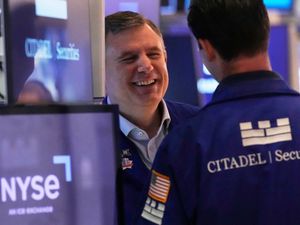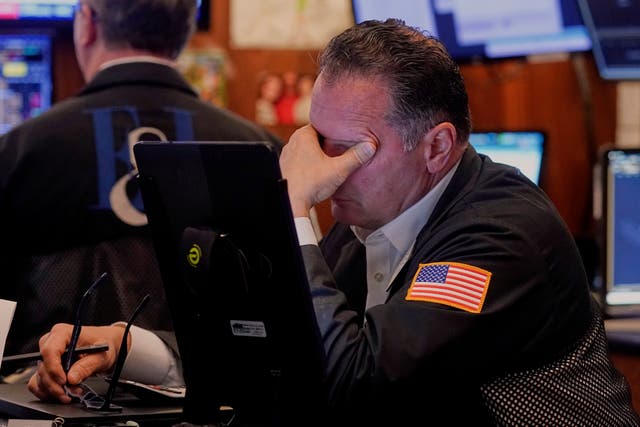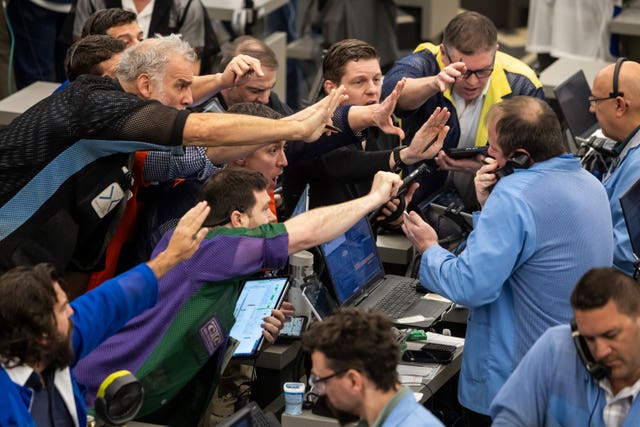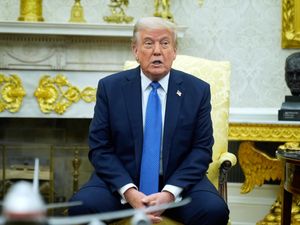S&P 500 jumps 1.8% as Wall Street closes a chaotic and historic week
The falling value of the US dollar and swings in other markets suggest fear is still high over Donald Trump’s tariffs and trade war with China.

US stocks jumped on Friday in another manic day on Wall Street, while the falling value of the US dollar and other swings in financial markets suggested fear is still high about escalations in President Donald Trump’s trade war with China.
The S&P 500 rallied 1.8%, after veering repeatedly between gains and losses, to cap a chaotic and historic week full of monstrous swings. The Dow Jones Industrial Average went from an early loss of nearly 340 points to a gain of 810 before settling at a rise of 619 points, or 1.6%, while the Nasdaq composite jumped 2.1%.
Stocks kicked higher as pressure eased a bit from within the US bond market. It’s typically the more boring corner of Wall Street, but it’s been flashing serious enough signals of worry this week that it’s demanded investors’ and Mr Trump’s attention.

The yield on the 10-year Treasury topped 4.58% in the morning, up from 4.01% a week ago. That’s a major move for a market that typically measures things in hundredths of a percentage point. Such jumps can drive up rates for mortgages and other loans going to US households and businesses, which would slow the economy, and they can indicate stress in the financial system.
But Treasury yields eased back as the afternoon progressed, and the 10-year yield regressed to 4.48%. That’s still higher than the day before, but not by as eye-wateringly much.
Susan Collins, president of the Federal Reserve Bank of Boston, told the Financial Times that the Fed “would absolutely be prepared” if markets become disorderly and “does have tools to address concerns about market functioning or liquidity should they arise”.
Several reasons could be behind this week’s jump in US Treasury yields, which is unusual because yields typically fall when fear is high.
Investors outside the United States could be selling their US bonds because of the trade war, and hedge funds could be selling whatever’s available in order to raise cash to cover other losses.
More worryingly, doubts may be rising about the United States’ reputation as the world’s safest place to keep cash because of Mr Trump’s frenetic, on-and-off tariff actions.
The value of the US dollar also fell again on Friday against everything from the euro to the Japanese yen to the Canadian dollar.
That comes even though gold, another place where investors have instinctually flocked when fear is high, rose to bolster its reputation as a safer haven.
The shaky trading came after China announced that it was boosting its tariffs on US products to 125% on Friday in the latest tit-for-tat increase following Mr Trump’s escalations on imports from China.

The repeated US tariff increases “on China has become a numbers game, which has no practical economic significance, and will become a joke in the history of the world economy,” a Finance Ministry spokesman said in a statement announcing the new tariffs.
“However, if the US insists on continuing to substantially infringe on China’s interests, China will resolutely counter and fight to the end.”
Rising tensions between the world’s two largest economies could cause widespread damage and a possible global recession, even after Mr Trump recently announced a 90-day pause on some of his tariffs for other countries, except for China.
All the uncertainty caused by the trade war is eroding confidence among US shoppers, which could affect their spending and translate into damage to the economy, which came into this year running at a solid rate.
A preliminary survey by the University of Michigan suggested sentiment among US consumers is falling even more sharply than economists expected.
The survey’s director, Joanne Hsu said: “This decline was, like the last month’s, pervasive and unanimous across age, income, education, geographic region, and political affiliation.”
According to Darrell Cronk, president of Wells Fargo Investment Institute: “We remain in the early innings of this global trade regime change, and while the 90-day pause on reciprocal tariffs temporarily reversed the market selloff, it does prolong uncertainty.”
That is why many on Wall Street are prepared for more swings to hit markets.
This past week began with huge swings for US stocks each day as rumours swirled and then got batted down about a possible 90-day pause on Mr Trump’s tariffs.

Then the US stock market surged to one of its best days in history after Mr Trump delivered a pause, before swinging to end the week.
All told, the S&P 500 rose 95.31 points Friday to 5,363.36. The Dow Jones Industrial Average climbed 619.05 to 40,212.71, and the Nasdaq composite climbed 337.14 to 16,724.46.
Friday’s swings came after a set of stronger-than-expected profit reports from some of the biggest US banks, which traditionally help kick off each earnings reporting season.
JPMorgan Chase, Morgan Stanley and Wells Fargo all reported stronger profits for the first three months of the year than analysts expected. JPMorgan Chase rose 4%, Morgan Stanley added 1.4% and Wells Fargo lost 1%.
Another report on inflation also came in better than expected. That could give the Federal Reserve more leeway to cut interest rates if it feels the need to support the economy.
But Friday’s report on inflation at the wholesale level was backward-looking, measuring March’s price levels. The worry is that inflation will rise in the coming months as Mr Trump’s tariffs make their way through the economy. And that could tie the Fed’s hands.
The University of Michigan’s survey suggested US consumers are bracing for inflation of 6.7% in the year ahead, which is the highest forecast since 1981, and such expectations can create a feedback loop that pushes inflation higher.
In stock markets abroad, indexes were scattershot around the world.
Germany’s DAX lost 0.9%, but the FTSE 100 in London added 0.6% as the government reported the economy, the world’s sixth largest, enjoyed a growth spurt in February.
Japan’s Nikkei 225 dropped 3%, while Hong Kong’s Hang Seng climbed 1.1%.





